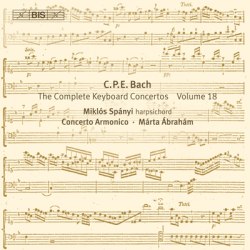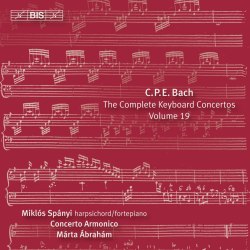|


|
Carl Philipp Emanuel BACH (1714 - 1788)
The Complete Keyboard Concertos Volume 18
Concerto in F (Wq 43,1 / H 471) [15:20]
Concerto in D (Wq 43,2 / H 472) [23:05]
Concerto in E flat (Wq 43,3 / H 473) [15:46]
Concerto in c minor (Wq 43,4 / H 474) [12:42]
Miklós Spányi (harpsichord)
Concerto Armonico Budapest/Márta Ábrahám
rec. November 2011, Phoenix Studios, Diósd, Hungary. DDD
BIS CD-1787 [68:12]
The Complete Keyboard Concertos Volume 19
Concerto in G (Wq 43,5 / H 475)* [12:27]
Concerto in C (Wq 43,6 / H 476)* [19:01]
Concerto in G (Wq 44 / H 477)** [15:04]
Concerto in D (Wq 45 / H 478)* [17:19]
Miklós Spányi (harpsichord*, fortepiano**)
Concerto Armonico Budapest/Márta Ábrahám
rec. April 2012, Phoenix Studios, Diósd, Hungary. DDD
BIS CD-1957 [65:04]
Comparison: Wq 43 - Andreas Staier, Freiburger Barockorchester (Harmonia Mundi, 2011)
The versatility of Carl Philipp Emanuel Bach’s oeuvre is impressive. With the exception of opera he contributed to any genre that was then in vogue. However, he was first and foremost a composer of keyboard music, and for that he was and is most famous. No composer of the 18th century has written as many concertos for keyboard and orchestra as CPE. The catalogue lists fifty solo concertos and ten sonatinas, plus two concertos and two sonatinas for two keyboards and orchestra. The six concertos which are listed as No. 43 in the catalogue of Wotquenne and which were published in 1773, take a special place.
Firstly, the fact that they were published was quite unusual for music of orchestral proportions. Printing all the parts was expensive, and such works didn't sell well because they were usually beyond the grasp of amateurs. These six concertos were specifically intended for "connoisseurs and amateurs" and the composer did everything to increase the number of inscriptions. The concertos were called "easy" and they were "expressly directed towards the nature of the harpsichord" which was still the most common keyboard instrument at the time. Moreover, they would include written-out cadenzas and suitable ornamentation in the slow movements. Lastly it was insisted that the instrumental parts were ad libitum, meaning that the solo parts could be played without accompaniment. However, one should often take such statements - and the title pages of editions - with a pinch of salt. A number of Beethoven's piano sonatas included a reference to the harpsichord as an alternative to the fortepiano, but that was not much more than a commercial ploy. In the liner-notes to his recording Andreas Staier insists that these concertos are technically no less complicated than the concertos Bach composed for his own use. He also believes that playing these works "as solo harpsichord pieces from the keyboard reduction in any case represents a poor substitute".
There is a second reason that these concertos are remarkable: they seem to build a cycle. The opening and closing examples are the most 'conventional' - if anything by Emanuel is conventional - and technically the easiest, relatively speaking. The two concertos at the heart of the set, Nos. 3 and 4, are the most surprising and the most daring. In all six we find many strong and often unexpected contrasts - and a number of movements are linked without any interruption. One finds many passages which are characterised by sudden and short interruptions by the orchestra, or short interventions by the harpsichord, sometimes just a couple of bars. These are features of Bach's music, with its influences of Empfindsamkeit and Sturm und Drang. The fourth and fifth concertos have more to offer. It is questionable, for instance, whether the Concerto No 4 in c minor has four movements or is in just one movement with four different sections. The relatively short opening allegro assai suddenly turns into a poco adagio which then is followed by a strongly contrasting tempo di minuetto. The closing section is an allegro assai, just like the opening section.
The Concerto No 3 in E flat has its idiosyncracies as well. "The second movement, Larghetto, is in a radiant C major and seems to embody a bright alternative world to the dark, warm E flat major of the Allegro. But already after the first harpsichord solo something astonishing occurs: the tutti replies with the opening motif of the first movement" (Staier). Bach even goes so far as gradually to replace the motifs from this second movement with material from the first. The Concerto No 5 in G also holds a surprise: the first movement begins with a slow introduction, something we know from the classical symphony but is highly unusual in a solo concerto. The first movement is followed by an adagio which is an extended version of the slow beginning of the concerto. The first movement of the Concerto No 2 in D consists of a sequence of five sections: the basic tempo of allegro di molto is twice interspersed with andante sections.
The performances by Miklós Spányi and Concerto Armonico are no real competition to Staier and the Freiburger Barockorchester. The many twists and turns in the orchestral score are much better conveyed by the Freiburgers, partly due to more contrasting tempi. The Concerto No. 1 in F is a telling example: the Freiburgers take 5:58 for the first movement, Concerto Armonico 6:44; in the last movement it is 4:10 vs 5:04. The Freiburger Barockorchester plays with greater differentiation, also in the treatment of dynamics. Concerto Armonico is rather bland and dynamically flat. As far as the solo part is concerned, Spányi's performances are not very interesting and too straightforward.
There is a specific problem here which concerns the choice of the harpsichord. In his 'performer's remarks' in the booklet of Volume 18 Spányi states that these concertos were specifically intended for the harpsichord which made this instrument the most obvious choice for the solo part. Which instrument to choose? He refers to the popularity of English instruments in North-Germany. However, is it imaginable that even the majority of the subscribers to this collection owned such an instrument? Spányi adds that in his experience this type of instrument was perfectly suitable for these concertos. That is especially the case as the machine stop and the swell device on a number of English harpsichords are perfectly suited to deal with the dynamic markings in these concertos. The problem was that he couldn't find an appropriate English instrument. It is easy to understand that no original instrument in playable condition was available but are there really no copies of such instruments around? I find that hard to believe. Anyway, considering the similarities between English instruments and harpsichords made in Antwerp in the late 18th century Spányi decided to use a copy of a 1745 Joannes Daniel Dulcken. However, this lacks the devices fitted to English harpsichords so a swell device was constructed which can be placed in the instrument. I find this rather odd. I doubt whether this is really needed; Staier's harpsichord has no pedals to change dynamics, and I haven't noticed any problems in this regard in his performance.
The apparent popularity of English instruments has also inspired Spányi to use an English fortepiano in the Concerto in G (Wq 44). It seems unlikely that those instruments were of the type he uses here: a Broadwood of 1798. At the time this concerto was written (1778) the press reported the composer performing a new concerto on the fortepiano. Considering the development in piano building in the last quarter of the 18th century it is unlikely that Bach on that occasion played an instrument like this Broadwood. I find this instrument too heavy and its sound too strong, even though Spänyi plays it well. Despite its anachronistic character I liked the performance better than that of the six Wq 43 and the Concerto in D (Wq 45).
Wq 44 and 45 are the last concertos by CPE, and that seems to indicate that these volumes are the last in this series. It is great that with the completion of this project every one of the keyboard concertos is available on disc. I haven't heard all of them, but those I have heard have given me no reason for real enthusiasm. In regard to interpretation I appreciate the series with solo works much more. That has everything to do with the contributions of Concerto Armonico which I find disappointing. I also think that Spányi makes a better impression on the clavichord and tangent piano than on the harpsichord. Those who have a special interest in this repertoire will purchase these discs anyway. Listening to these concertos one cannot avoid being impressed by the inventiveness of their composer. However, as far as interpretation is concerned, it is to be hoped that other performers will turn their attention to this exciting repertoire and not confine themselves to a handful of rather well-known concertos.
Johan van Veen
http://www.musica-dei-donum.org
https://twitter.com/johanvanveen
 |
 |
|
